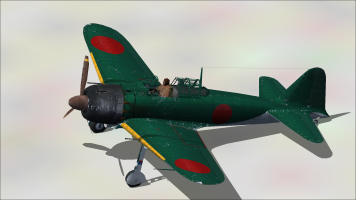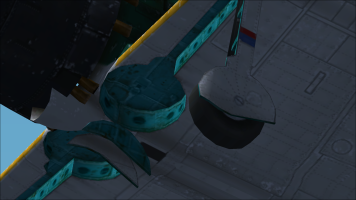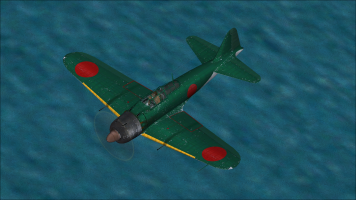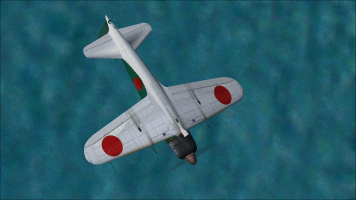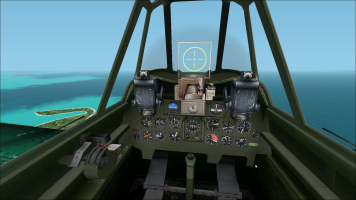-
There seems to be an uptick in Political comments in recent months. Those of us who are long time members of the site know that Political and Religious content has been banned for years. Nothing has changed. Please leave all political and religious comments out of the forums.
If you recently joined the forums you were not presented with this restriction in the terms of service. This was due to a conversion error when we went from vBulletin to Xenforo. We have updated our terms of service to reflect these corrections.
Please note any post refering to a politician will be considered political even if it is intended to be humor. Our experience is these topics have a way of dividing the forums and causing deep resentment among members. It is a poison to the community. We appreciate compliance with the rules.
The Staff of SOH
You should upgrade or use an alternative browser.
Blackbird Sims Mitsubishi A6M5 Released
- Thread starter Akatsuki
- Start date
Cazzie
SOH-CM-2024
Cazzie
AH's Zero A5M6 in MSFS 2024
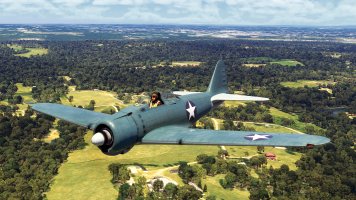
Actual B & W images
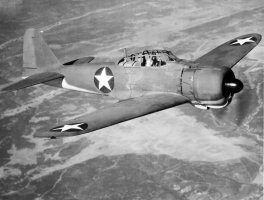
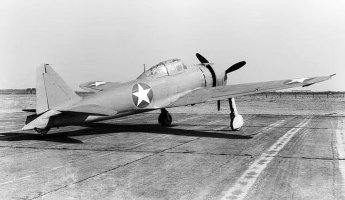
Bomber_12th
SOH-CM-2025
I've been working on one just about every day for the past couple of weeks, though there is still a long ways to go with it (a lot of texture files to cover, and all high-resolution). I hope to have it in the sim, soon.I wish there was a clean livery in IJN green, John?
Bomber_12th
SOH-CM-2025



Bomber_12th
SOH-CM-2025
I've now uploaded my repaint of the Planes of Fame Air Museum's A6M5 Zero, and it's available here: https://flightsim.to/file/96086/a6m5-zero-planes-of-fame-air-museum-n46770











Bomber_12th
SOH-CM-2025
I took a deep dive into the history of this aircraft while making this repaint, and it's amazing how well-documented it is. I got to see the aircraft in person in 2014, but unfortunately it was just in pieces then, when undergoing its latest restoration/major overhaul. It's really neat to have seen the aircraft's original US logbook from the time it was being tested and evaluated in the US, following its capture. As I wrote in the repaint description, a large number of military and noteworthy civilian test pilots flew the aircraft after its arrival in the US, including Charles Lindbergh, and each made their own entries in the aircraft's logbook. It flew a whopping 190 hours during that time, before war's end. I however couldn't find any information on Japanese pilots who may have flown it when it was still part of Japan's Naval Air Corps, from May 1943 until its capture in June 1944, so I assume nobody knows. It really got around though, from defending the skies over the home islands of Japan, to defending the skies over Iwo Jima and then the Mariana Islands. The Japanese 261st Air Group, for which the Zero belonged, was last led by Capt. Masanobu Ibusuki, who took part in just about every major battle in the Pacific, including the attacks on Pearl Harbor and Port Darwin, the Battles of Midway and Guadalcanal, the Marianas Turkey Shoot and the Battle of the Philippine Sea (during which time the Planes of Fame's Zero was captured on Saipan), and he would survive the war.
There are some great videos featuring this aircraft on Youtube, including these:
A 1986 documentary about the aircraft's original restoration and first return visit to Japan, in 1978:
The 1998 Roaring Glory Warbirds episode featuring the Planes of Fame Zero with, restorer and pilot, Steve Hinton:
A couple of neat facts pointed out in the Roaring Glory video - the Zero's original landing gear downlock assembly is an exact copy of that used on the Douglas SBD Dauntless, with the design having been purchased by the Japanese under license prior to WWII, and the design of the propeller hub was also purchased under license from Hamilton Standard, prior to WWII. Steve Hinton mentions that the Japanese-made propeller hub is such an exact match to the Hamilton Standard design that they have been able to replace parts of the original Japanese prop hub, as needed, using Hamilton Standard parts.
Note, that the aircraft's paint scheme has changed several times since when it was originally restored in the 1970s, however the paint scheme it currently wears, since its restoration in 2016, and for which my repaint depicts, is the only paint scheme it has had that is accurate to how it once looked when operated by the Japanese 261st Air Group. The photo comparison below shows it when it was captured on Saipan by US Marines in June 1944, and below is the same aircraft today, as my repaint depicts.
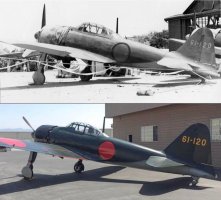
Also, although the repainter doesn't mention it at all, this repaint (https://flightsim.to/file/95496/blackbird-a6m5-zero-taic-5-u-s-captured) is also of the Planes of Fame's A6M5, depicting how it looked after it was brought back to the US and used for testing and evaluation. It was given US insignias, applied over the Japanese paint, and also gained the tail code/designation TAIC 5 (TAIC stood for Technical Air Intelligence Center, a US Navy unit that specialized in evaluating captured foreign aircraft).
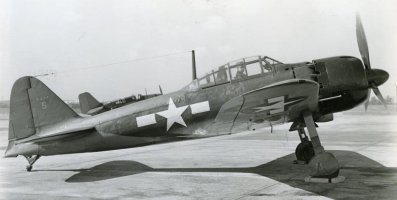
Bomber_12th
SOH-CM-2025
Hollister56
Members +
What is the effect that causes the deep indentation along the rivet lines of the aircraft? Your repaint is very well researched and done, and looks great, but that effect seems to be way over done, as I don't recall that look when being up close to these airplanes. Look at Post #33, pictures 2,3,4, and 5. You can see it as it's very pronounced in those pictures. Thanks again for the prepaint and what book did you order? I have several books on the Zero, also the informative posts about the history of this aircraft, it made for very interesting reading. Ed
Bomber_12th
SOH-CM-2025
Yeah, the oil canning effect, from the stressed-skin construction, is a bit exaggerated. It's created through the use of normal maps (or sometimes still called bump maps), which just adds the 3D effect. That aspect is purely default, as it comes from Blackbird Simulations - I didn't touch those at all. If it is a big-enough issue for users, I just assume Blackbird address it/improve those aspects. If they were .DDS textures, I'd be able to easily edit them/tone them down a bit, within the span of only an hour or two, but for some reason trying to convert them from the new MSFS 2024 KT2X format to an editable format, they just don't look good at all/not workable - leaving no good base to easily edit. Making new ones, from scratch, would take far too much time (weeks, months perhaps), and I also really haven't had a problem with the default normal maps, myself, so there's no ambition on my part to do such a thing.Hello John,
What is the effect that causes the deep indentation along the rivet lines of the aircraft? Your repaint is very well researched and done, and looks great, but that effect seems to be way over done, as I don't recall that look when being up close to these airplanes. Look at Post #33, pictures 2,3,4, and 5. You can see it as it's very pronounced in those pictures. Thanks again for the prepaint and what book did you order? I have several books on the Zero, also the informative posts about the history of this aircraft, it made for very interesting reading. Ed
With regard to the book I've purchased in order to complete my next Zero repaint(s), its "Pacific Profiles Vol. 5". It appears to have quality illustrations of all of the exterior stenciling that I need.

